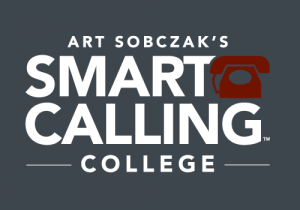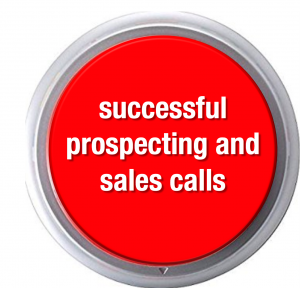

“Say ‘please’ and ‘thank you’.”
“Listen to your mother,”
“Eat your vegetables.”
These are the fundamentals.
And why are they the fundamentals?
Because fundamentals comprise a proven success recipe that has withstood the test of time.
And the same is true with sales.
People can and do try to complicate things with technology. And avoid actually talking to people by following the newest shiny object or fad from self-proclaimed guru in a Facebook ad.
But bottom line, sales is about humans talking to humans, and helping people buy.
People come through my training and say, “This really reminded me I need to get back to the basics.” Not just get back to the basics, I tell them. Use them.
We’re starting a new session of my Smart Calling College on January 22, the online/hybrid-live comprehensive workshop where we take a deep dive into every part of the proven call process. Participants drill on the pieces of the process, building their what-to-say’s in each part so they can confidently and conversationally use those words when they need them. Today, I’ll go through each part of that process.
Whether you join us in the College training or not, you can benefit from this cheat sheet/easy button/mini-lesson on the parts of the call, along with how-to’s you can use.
I’ll present, in order, the fundamental parts of the professional prospecting (Smart Call) and sales call, and what I consider to be some of the most important points of each along with common mistakes to avoid.
1. Pre-Call Planning
A. Understanding the Other Person
People buy for their reasons not yours. If you approach each call by thinking you need to move some product, you won’t do nearly as well as if you start each call by asking, “As it relates to what I sell, what do buyers want most, and what do they want to avoid most?” You then can use these answers, virtually word-for-word in opening statements, on voice mail, in response to screeners’ tough questions, and to create great need-development questions. Do your online and offline research so that your can tailor a relevant message. This is key to placing a Smart Call.
B. Your Call Objectives
Every call must start with a destination in mind, a Primary Objective, defined as “What do I want them to DO as a result of this call?” Just like traveling to a far-off destination, you then use that target to either work forward or backward to map out the route. And your Secondary Objective, defined as what you can attempt at minimum, provides you a “win” on every call, regardless of how small. Which is imperative for your mindset to keep going.
2. Pre-Buyer Conversations
Treat everyone—especially screeners-- as you would the customer. This person determines whether or not you’ll even have a chance to speak with the buyer. Prior to your call you need to prepare for what you’ll say upon reaching voice mail and screeners. And keep in mind that screeners aren’t there to get rid of all salespeople, just the ones who are self-interested and waste the buyer’s time.
To ensure you have something of value, and to position it as such, you need to collect information before even talking to your buyer. Gather as much information as you can from whomever you are able, prior to speaking with your prospect. This enables you to make your calls Smart.
Have a reason for needing to speak with the decision maker, and be prepared to sell this to the screener.
They’re asking, “Does this person have anything of interest, or of value for the boss?” I
If leaving a message on voice mail, or with a screener, be certain it offers a hint of a benefit that sparks curiosity, but doesn’t talk about products/services.
Common Screener Mistakes: Being evasive and condescending with the screener; wasting information opportunities by not asking questions; leaving messages that create resistance—not interest—by talking about what you want to sell, not what they’re really interested in.
3. Opening Statements
There are two objectives for any opening:
- To put them in a positive, receptive frame of mind, and,
- Move them to the questioning phase of the call.
Your opening must include a result or hint of result they can receive, and for follow-up calls, it should be a natural progression from the previous call.
You must answer, “What’s in it for me?” for the listener, or they will immediately begin the getting-rid-of-you process.
Common Opening Mistakes: talking about the product or service…what the salesperson wants to do, not what the listener wants; not having prepared openings…winging it, and asking for a decision (such as appointment).
4. Questioning
The essence of professional selling: get information, then give it.
Benefits are only benefits if the listeners perceive them to be. Otherwise, you could be creating objections by rambling about irrelevant features they not only don’t want, but certainly do not want to pay extra for. Buyers will sell themselves, or tell you exactly what you need to know in order to help them, if you just give them the opportunity.
Get information before you give it—how could you make an effective recommendation otherwise? After qualifying them, which preferably is done before speaking with them, the goal is to first identify the need, problem, pain, or the desire to enhance their situation. If it is latent, we must try to help them realize it through questions.
Common Questioning Mistakes: not listening to the answers to questions, therefore not layering more questions to dig deeper to magnify the problem; not learning and understanding the decision-making hierarchy and internal buying process.
5. Recommendation
This should be the shortest part of a call. Every thing you say here is based upon what you learned in the previous phase, the questioning.
If during the questioning you learn that they are interested in something because it will help them avoid or gain something else, tell them how. It doesn’t get any easier than this!
Somehow, though, salespeople are overcome by the compelling need to talk about their products or services, and how great they think they are. Hey! They don’t care what you think!
You should only talk about your product/service after knowing specifically how it will solve the problem, meet their need, etc. Then you can tailor your remarks specifically and personally for the listener.
Common Mistakes: “Premature Presentation,” which is pitching before knowing what they’re interested in, talking about points irrelevant to the listener; not seeking, or getting feedback during discussion of benefits.
6. Commitment and Closing
This is not the major event in a sales call. It makes me crazy when I see sales reps and even managers who think that sales is primarily based on good closing techniques. That’s like saying a good football offense is primarily based on throwing the long bomb. Both are similar plays: going for broke from a long distance. Just like in football, if you execute all the other parts of your game correctly, you can almost walk in for the score or sale.
Not to downplay the importance of commitment, however. You should get commitment of some type on every call you plan on following up with. Otherwise you’re wasting time.
Here’s the most important part of getting commitment: being comfortable with asking. Asking often, asking large, and asking at the appropriate times. It’s the natural, logical, validation of the professional sales process up to this point. But you still must ask.
Commitment must be gained on every contact in order to move the process forward. If there is to be a follow-up contact, and information is to be sent, there must be commitment on behalf of the prospect regarding that material.
Common Mistakes: Asking too early; not asking soon enough (if buying signals have been expressed); not asking at all; agreeing to, or suggesting, a follow-up—and sending information—without having any commitment.
7. Resistance and Objections
Hear this: objection rebuttals don’t work. They insult people and tell them they’re wrong.
The only way to deal with resistance and objections professionally is to get them to talk about their reasons for resisting, which hopefully then gets them to doubt their beliefs.
Objections can be avoided by doing everything else correctly up to this point in the call. When you do hear them, resist the tendency to attack them. You must back up and revisit the questioning stage of the call. The voiced objection is simply a symptom of the real problem.
Common Mistakes: Using slick, prepared, objection rebuttals that only tell people they’re wrong and intensify the resistance; giving up before attempting to understand the reason behind the problem.
8. Wrapping Up and Setting Up the Next Action
Want to have a great follow-up call and avoid the goofy “I’m just calling you back”? It's here that you determine the success of your follow-up call. Waiting until the follow-up call is too late. Make sure they know what they are to do, and what you'll do before the next call.
At the end of calls you must summarize agreed-to actions by both parties, and set the agenda for the next call.
There you have it, all the basic parts of the successful prospecting and sales call. It’s not rocket science. Follow these and you will be successful.
If you’d like to build on and master these parts of the process so that you confidently and conversationally use the right words in any situation to create interest and get people to take action, I invite you to join me in our Smart Calling College masterclass starting next week.
See complete information here. It’s time. Let’s do this.
